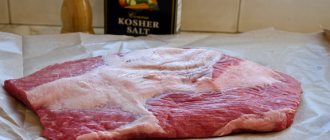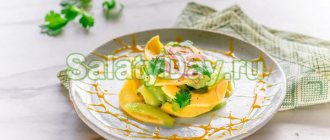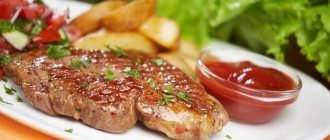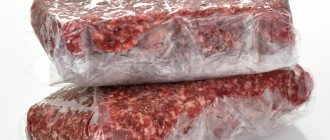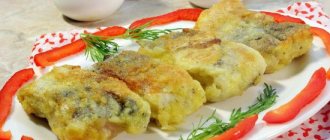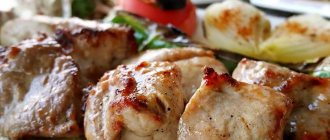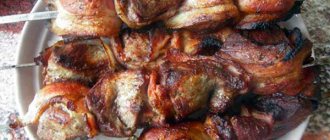Blood fried with cracklings
Probably, fried blood, for some, is a rather specific dish. For me this is not the case and I hope there are lovers on the Forum who will also find this dish attractive. This is another recipe from my childhood. Every year, in late autumn, the parents stabbed the pig, and the mother fried the blood. Without any problems, blood could be found on the market - it was sold in three-liter cylinders. But this was in the south. Here, unfortunately, blood is tight, and you can’t even get intestines for homemade sausage, only sometimes you can “snatch” a pig’s stomach. And then I make a kolbik. But this is a completely different story, so let’s return to the topic.
Agree, it is quite difficult to find an alternative to blood. But I solved this problem and, to be honest, I am very proud of it. I don’t remember how this idea came to me, but having implemented it, I realized that everything was a success, and now I can enjoy fried blood at any time!
Pork lung - 500 grams
Lard - 300 grams
It is better to take the light one in a rich red color. We free the lung from the trachea, if present, and cut it into pieces.
Then, let's take care of our lard - separate it from the skin and cut it into small pieces. Immediately throw the lard into the frying pan and fry over low heat with the lid open to render the fat.
While the lard is fried, we pass our lungs through a meat grinder.
But don’t forget to watch the lard - stir it periodically.
The lard should be fried until fully cooked.
A sufficient amount of fat will be rendered from the lard. If you think there's too much fat, don't worry—it really is. The blood will absorb almost all the fat, and the dish will not be greasy and cloying. Pour the minced lungs into a frying pan with lard.
At this stage, you can salt the blood, or you can salt the blood that is almost ready - this is not critical. The main thing is not to oversalt.
Cover with a lid and simmer over low heat until tender, stirring occasionally. In terms of time, this is about half an hour or until the liquid has completely evaporated. But here, do not overdo it and do not overcook the blood, otherwise it will turn out dry.
At my husband's request, I served the blood with a side dish of mashed potatoes. But, in principle, you can do it without a side dish - a good slice of bread and a huge juicy tomato will be an excellent alternative to any side dish.
How to fry pork in a frying pan so that it is soft and juicy
This is the most consumed type of meat in the world. It has been consumed as food since the 5th millennium BC. Of course, we all love pork kebab, but in a modern city we don’t always have the opportunity to do it. Just don’t be upset, believe me, meat can be cooked perfectly in another way.
Today I will tell you how tasty, simple and juicy it is to fry pork in a frying pan so that it is soft. I also advise you to look at recipes for juicy and soft beef in the oven.
We don’t need any special skill to prepare, just follow the tips and step-by-step instructions. When choosing a part of a carcass for frying in a frying pan, remember that the neck part is more suitable, and ham and carbonate are also suitable for many recipes.
Some tips for choosing a product. It is best to cook homemade meat, but if this is not available, then we buy it at the market and not in the store. Look for sellers who will separate the required piece in front of you. You can check the freshness by simply pressing on it; its shape should be restored instantly. If the piece is stale, we will see yellow fat and a dark red surface on the product.
Fried pork blood
Products
Pork blood - 600 milliliters (2 cups) Lard - 150 grams Onion - 1 head Milk - 0.5 cups Salt - 1 whisper
How to fry pork blood
1. Cut the lard into small pieces with half a centimeter sides. 2. Peel 1 onion, rinse with water, chop finely. 3. Select blood clots from pork blood and grind them (you can go through all the blood with a blender). 4. Heat a frying pan over medium heat, add lard and fry for 5 minutes until cracklings form. 5. Pour the onion into the frying pan and fry it for another 5 minutes until golden brown. 6. Then pour in 2 cups of pork blood without clots and 0.5 cups of milk, stir, add 1 pinch of salt. 7. Fry pork blood in a frying pan for 15 minutes without a lid until the liquid has evaporated from the pan. 8. Remove the pan from the stove, let cool and serve.
Fried blood with eggs
Products
Pork blood - 600 milliliters Eggs - 8 pieces Wheat flour - 10 tablespoons Corn flour - 2 tablespoons Garlic - 8 cloves Vegetable oil - 4 tablespoons Parsley - several sprigs Red pepper, black pepper, salt - 1 pinch each
How to fry pork blood with egg
1. Wash the parsley and chop finely. 2. Peel and chop the garlic. 3. Break the eggs, pour into a bowl, beat well until a homogeneous mass is formed. 4. Add 300 milliliters of pork blood to the eggs, mix well. 5. Add corn and wheat flour to the mixture, sprinkle with herbs, a pinch of salt and red pepper; mix well until smooth. 6. Pour vegetable oil into a frying pan, place on low heat and heat. 7. Place the mixture of blood, eggs, flour, seasonings into a frying pan and fry for 20 minutes. When frying pork blood, do not cover it with a lid and stir constantly. 8. Remove the frying pan from the heat, sprinkle the fried pork blood with chopped garlic, add a pinch of black pepper. 9. Serve the fried pork blood hot.
Croatian cuisine
- Lamb with vegetables
- White sour cream sauce
- White soup
- Brodet in Bokel style
- Bunjevac pork paprikash
- Potato brew with pork feet
- Wine goulash
- Wine paprikash from carp
- Lamb liver cabbage rolls
- Stuffed cabbage rolls in Herzegovinian style
- Winegrowers' goulash from Moslavina
- Goulash from hunting sausages
- Pork liver goulash
- Goulash with smoked meats in Trnyansky style
- Goose baked with apples
- Fried pork liver
- Fried cutlets in wine in Slavonian style
- Fried pork kidneys
- Fried veal intestines
- Fried pork chin
- Australian cuisine
- Austrian cuisine
- Azerbaijani cuisine
- American cuisine
- English cuisine
- Armenian cuisine
- African cuisine
- Belarusian cuisine
- Bulgarian cuisine
- Hungarian cuisine
- Dutch cuisine
- Georgian cuisine
- Indian food
- Spanish cuisine
- Italian Cuisine
- Chinese cuisine
- Korean cuisine
- Lebanese cuisine
- Mexican cuisine
- German cuisine
- Polish cuisine
- Baltic cuisine
- Russian kitchen
- Thai cuisine
- Tatar cuisine
- Turkish cuisine
- Turkmen cuisine
- Uzbek cuisine
- Ukrainian food
- Finnish cuisine
- French cuisine
- Yugoslav cuisine
- Japanese food
Fkusnofacts
— After cooking, if there is any pork blood left, it should be frozen. You can store it in this condition for no more than 2 months.
- To prepare fried pork blood, you can use a pig's lung - it contains a lot of blood. Only the lung should be fresh, and the blood should be passed through a meat grinder.
— When salting pork blood, you should be careful, because the blood itself is salty.
Access to this page has been denied because we believe you are using automation tools to view the website.
This may happen as a result of:
- Javascript is disabled or blocked by an extension (such as ad blockers)
- Your browser does not support cookies
Make sure Javascript and cookies are enabled in your browser and you are not blocking them from loading.
Link ID: #e702f2b0-0bf3-11ea-a9fb-4df790772f3c
- pork blood - 500 ml;
- lard - 50 g;
- garlic - 2-3 cloves;
- rosemary - 2-3 sprigs (optional);
- salt - to taste;
- ground black pepper - to taste.
Which meat is better to choose?
When choosing pork, you should pay attention to quality criteria:
Fresh meat has a characteristic, subtle smell of blood. A weathered or missing piece spreads the smell of rot. Pink color indicates the young age of the animal. The darker the meat, the older it is. But sometimes a dark shade, especially if the color is uneven, indicates that the pig was slaughtered incorrectly, as a result of which a large amount of blood went into the meat fibers. Young pork has a tender, pliable texture. If you press the piece with your fingertip, the depression will level out in 5–10 seconds. Old meat is tough and rough.
When choosing pork, pay special attention to packaging. If it is sold open, then look to see if there are any blood pools under the piece. The same applies to plastic vacuum bags. If they contain liquid, it is better not to buy such pork.
A sign of high quality meat is an even layer of fat. Such a criterion as marbling is more often attributed to pork than to beef, because the former always has a lot of fat. But we need to look at how it is distributed. Fillet with a uniform marble pattern is an excellent option for delicious steaks. Therefore, for their preparation, carbonate, loin, and neck are often chosen.
After purchase, the pork is washed and placed in bags or in containers with access to air. You need to make several holes in the polyethylene at the top: pork does not “like” storage in sealed packages. Once frozen, it can be stored in the freezer for up to six months. Ready steaks are stored in the refrigerator for 1-1.5 weeks, provided that it has been in the marinade for several hours.
Fried pig blood recipe
Access to this page has been denied because we believe you are using automation tools to view the website.
This may happen as a result of:
- Javascript is disabled or blocked by an extension (such as ad blockers)
- Your browser does not support cookies
Make sure Javascript and cookies are enabled in your browser and you are not blocking them from loading.
Link ID: #20c716f0-0caf-11ea-bec6-857a8398b3dd
Fry the pork blood for 15 minutes without a lid until the liquid evaporates.
Fried pork blood
Products
Pork blood - 600 milliliters (2 cups) Lard - 150 grams Onion - 1 head Milk - 0.5 cups Salt - 1 whisper
How to fry pork blood
1. Cut the lard into small pieces with half a centimeter sides. 2. Peel 1 onion, rinse with water, chop finely. 3. Select blood clots from pork blood and grind them (you can go through all the blood with a blender). 4. Heat a frying pan over medium heat, add lard and fry for 5 minutes until cracklings form. 5. Pour the onion into the frying pan and fry it for another 5 minutes until golden brown. 6. Then pour in 2 cups of pork blood without clots and 0.5 cups of milk, stir, add 1 pinch of salt. 7. Fry pork blood in a frying pan for 15 minutes without a lid until the liquid has evaporated from the pan. 8. Remove the pan from the stove, let cool and serve.
Fried blood with eggs
Products
Pork blood - 600 milliliters Eggs - 8 pieces Wheat flour - 10 tablespoons Corn flour - 2 tablespoons Garlic - 8 cloves Vegetable oil - 4 tablespoons Parsley - several sprigs Red pepper, black pepper, salt - 1 pinch each
How to fry pork blood with egg
1. Wash the parsley and chop finely. 2. Peel and chop the garlic. 3. Break the eggs, pour into a bowl, beat well until a homogeneous mass is formed. 4. Add 300 milliliters of pork blood to the eggs, mix well. 5. Add corn and wheat flour to the mixture, sprinkle with herbs, a pinch of salt and red pepper; mix well until smooth. 6. Pour vegetable oil into a frying pan, place on low heat and heat. 7. Place the mixture of blood, eggs, flour, seasonings into a frying pan and fry for 20 minutes. When frying pork blood, do not cover it with a lid and stir constantly. 8. Remove the frying pan from the heat, sprinkle the fried pork blood with chopped garlic, add a pinch of black pepper. 9. Serve the fried pork blood hot.
What thins the blood?
The liquid component of human blood is plasma. Density is regulated by shaped elements. When the balance is upset towards the blood cells, the viscosity of the blood increases and it thickens. With this phenomenon, the load on the heart increases. The likelihood of heart attack, thrombosis, atherosclerosis, stroke, varicose veins, VSD and other diseases increases.
Thick blood transports nutrients poorly and does not fully remove waste products. As a result, the brain and other organs do not fully receive the components necessary for life.
Fkusnofacts
— After cooking, if there is any pork blood left, it should be frozen. You can store it in this condition for no more than 2 months.
- To prepare fried pork blood, you can use a pig's lung - it contains a lot of blood. Only the lung should be fresh, and the blood should be passed through a meat grinder.
— When salting pork blood, you should be careful, because the blood itself is salty.
- pork blood - 500 ml;
- lard - 50 g;
- garlic - 2-3 cloves;
- rosemary - 2-3 sprigs (optional);
- salt - to taste;
- ground black pepper - to taste.
Cooking steps
Prepare the necessary ingredients. Cut the lard into thin pieces and place in a well-heated frying pan.
After a minute, when the rendered fat appears, place the peeled garlic cloves and rosemary sprigs into the pan. Fresh rosemary can be replaced with dried or other aromatic herbs.
Fry the lard over medium heat on all sides for 3-4 minutes, then remove the greaves, garlic and rosemary from the frying pan.
Prepare pork blood: pour it into a deep bowl and use a fine strainer to collect blood and fat clots.
How to properly fry pork on a grill pan
The easiest way to prepare a piece of pork for dinner is to fry it in a grill pan. This dish is very simple, does not require special preparation, is prepared quickly and is delicious.
Ingredients:
- Pork fillet - 1 pc.
- Soy sauce - 2 tbsp. spoons
- Olive oil - 2 tbsp. spoons
- Balsamic vinegar - 2 tbsp. spoons
- Ginger - 1.5 cm.
- Garlic - 2 cloves
- Salt, black pepper - to taste
Cooking method:
1. Wash the fillet, dry it with a paper towel and cut it into the desired pieces.
2. For the marinade, chop the garlic and ginger thinly, put it in a container, add soy sauce, vinegar and olive oil. Pepper, salt, stir well and pour it over the pork.
3. Cover with cling film and leave for 30 minutes to marinate everything. Heat the grill pan, place the meat at a distance from each other, fry on each side for 3 minutes.
We check the dish, if it is ready, then put it immediately on a plate with a lettuce leaf and serve. Bon appetit.
Benefits of Fried Blood
- Vitamin B2
is involved in redox reactions, helps to increase the color sensitivity of the visual analyzer and dark adaptation. Insufficient intake of vitamin B2 is accompanied by impaired condition of the skin, mucous membranes, and impaired light and twilight vision. - Choline
is part of lecithin, plays a role in the synthesis and metabolism of phospholipids in the liver, is a source of free methyl groups, and acts as a lipotropic factor. - Vitamin B5
is involved in protein, fat, carbohydrate metabolism, cholesterol metabolism, the synthesis of a number of hormones, hemoglobin, promotes the absorption of amino acids and sugars in the intestines, and supports the function of the adrenal cortex. A lack of pantothenic acid can lead to damage to the skin and mucous membranes. - Vitamin B6
is involved in maintaining the immune response, processes of inhibition and excitation in the central nervous system, in the transformation of amino acids, the metabolism of tryptophan, lipids and nucleic acids, promotes the normal formation of red blood cells, and maintaining normal levels of homocysteine in the blood. Insufficient intake of vitamin B6 is accompanied by decreased appetite, impaired skin condition, and the development of homocysteinemia and anemia. - Vitamin B12
plays an important role in the metabolism and transformation of amino acids. Folate and vitamin B12 are interconnected vitamins that are involved in hematopoiesis. A lack of vitamin B12 leads to the development of partial or secondary folate deficiency, as well as anemia, leukopenia, and thrombocytopenia. - Vitamin H
is involved in the synthesis of fats, glycogen, and amino acid metabolism. Insufficient consumption of this vitamin can lead to disruption of the normal condition of the skin. - Vitamin PP
is involved in redox reactions of energy metabolism. Insufficient vitamin intake is accompanied by disruption of the normal condition of the skin, gastrointestinal tract and nervous system. - Potassium
is the main intracellular ion that takes part in the regulation of water, acid and electrolyte balance, and is involved in the processes of conducting nerve impulses and regulating blood pressure. - Phosphorus
takes part in many physiological processes, including energy metabolism, regulates acid-base balance, is part of phospholipids, nucleotides and nucleic acids, and is necessary for the mineralization of bones and teeth. Deficiency leads to anorexia, anemia, and rickets. - Iron
is part of proteins with various functions, including enzymes. Participates in the transport of electrons and oxygen, ensures the occurrence of redox reactions and activation of peroxidation. Insufficient consumption leads to hypochromic anemia, myoglobin deficiency atony of skeletal muscles, increased fatigue, myocardiopathy, and atrophic gastritis. - Cobalt
is part of vitamin B12. Activates enzymes of fatty acid metabolism and folic acid metabolism. - Copper
is part of enzymes that have redox activity and are involved in the metabolism of iron, stimulates the absorption of proteins and carbohydrates. Participates in the processes of providing oxygen to the tissues of the human body. Deficiency is manifested by disturbances in the formation of the cardiovascular system and skeleton, and the development of connective tissue dysplasia. - Molybdenum
is a cofactor for many enzymes that ensure the metabolism of sulfur-containing amino acids, purines and pyrimidines. - Chromium
is involved in the regulation of blood glucose levels, enhancing the effect of insulin. Deficiency leads to decreased glucose tolerance. - Zinc
is part of more than 300 enzymes and is involved in the processes of synthesis and breakdown of carbohydrates, proteins, fats, nucleic acids and in the regulation of the expression of a number of genes. Insufficient consumption leads to anemia, secondary immunodeficiency, liver cirrhosis, sexual dysfunction, and the presence of fetal malformations. Research in recent years has revealed the ability of high doses of zinc to disrupt the absorption of copper and thereby contribute to the development of anemia.
still hide
You can see a complete guide to the healthiest foods in the “My Healthy Diet” app.
